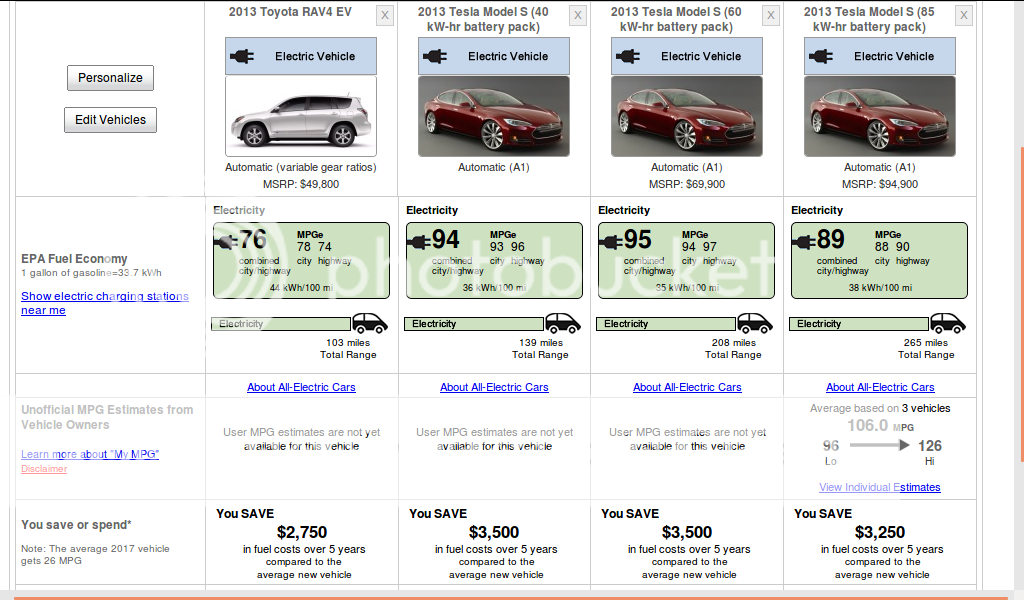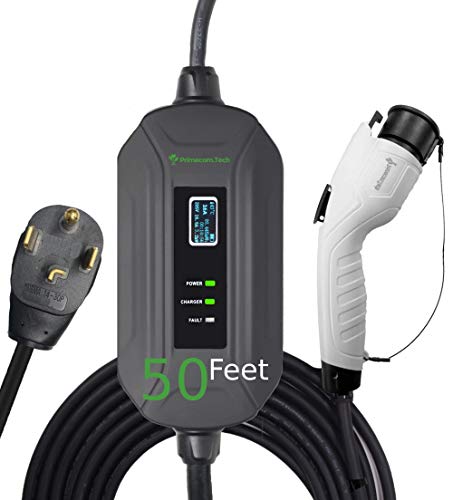davewill said:
The higher drag coefficient, higher ground clearance, the larger, heavier tires, and....
I kept wondering if our RAV4 EV does indeed have larger and heavier wheels than the 2013 Tesla Model S. Every time I see the Model S I always notice it has pretty big wheels, so I checked to see if it was true:
"19" cast aluminum wheels with all-season tires (Goodyear Eagle RS-A2 245/45R19). Note: optional 21" wheels come with Continental Extreme Contact DW 245/35R21 tires"
According to "http://www.teslamotorsclub.com/showwiki.php?title=Model+S+-+FAQ":
Quote:
--
"Width:
19x8 for 19" wheels
21x8.5 for 21" wheels
Weights:
19" Wheels: 13.74kg ~30lbs each (according to a Tesla engineer)
19" All Season Tires: 27lbs each (according to Tire Rack for Eagle RS-A2 245/45 19")
21" Wheels: 35lbs
21" Continental ExtremeContact DW Tires: 26lbs"
And here is a quote from Tony I found in the forums:
The current wheels on the RAV4 EV are the same as the V6 Limited:
Tire -------------------Rim ------Bolt pattern---Thread--Center Bore (mm)
225/65 R17------6.5Jx17 ET39---5x114.3----M12 x 1.5----60.1 (base)
225/65 R17------7Jx17 ET39-----5x114.3----M12 x 1.5----60.1 (V6 Limited, EV)
235/55 R18------7.5Jx18 ET40---5x114.3----M12 x 1.5----60.1 (Sport)
So our Rav4 EV has a single option and the 2013 Tesla Model S has two options:
225/65R17 Rav4 EV
245/45R19 Model S
245/35R21 Model S
The 2013 Tesla Model s has wider and taller wheels so I do not believe that we have the larger wheels. As for the weight:
http://www.myrav4ev.com/forum/viewtopic.php?p=25510
http://www.myrav4ev.com/forum/viewtopic.php?f=9&t=778&start=20
On an ICE forum they said the 17" limited wheels weighed 23 lbs 6 oz each. With stock tires someone said it was 51 lbs. I could be wrong but with a pair of lightweight wheels from TireRack you could save quite a bit of weight.....
Again, assuming its the same wheel as the ICE limited, its a 17x7" wheel. The same width as the Enkei Racing RPF1's which are the lightest wheels TireRack offers for the Rav4.
The Michelin Energy Saver A/S tires are 26 lbs each.
The Bridgstone Ecopia EP422 tires are 24 lbs each.
There are plenty more options but I know those are two popular tires.
So with Enkei Racing RPF1's and Bridgstone Ecopia EP422 your total would be 47lbs, 6 oz roughly.
If the stock set up is 51 lbs you'd be saving about 4 lbs 6 oz.
I'm looking into this again. I just weighed my stock wheels and tires, they are 45.6lbs.
The 16" Enkei RPF1's 17x7" are 14.6lbs
Ecopia EP422 are 25lbs
Champion Fuel Fighter tires are 25lbs
That would be 39.6lbs total, per wheel. A savings of only 6lbs per wheel.
225/65R17 Rav4 EV 45.6lbs lbs Total?
245/45R19 Model S 30+27 lbs
245/35R21 Model S 35+26 lbs
It also appears that we don't have the heavier tires! So what else is there left?
Our RAV4 EV is
Lighter
Narrower
Shorter
Lighter Wheels
Smaller Wheels?
So to add to the old table:
CONS:
Higher Drag Coefficient
Stands 9 Inches Taller
PROS:
615.3 Lbs Lighter
5 Inches Narrower (Frontal Area Drag? Though overall still have higher CD)
Narrower & Smaller Wheels
DEBATABLE:
FWD?
And regarding the fact that our RAV4 EV stands 9 Inches Taller... does this measurement take into account the higher stature or is it just body tallness? Because SUVs stand higher due to factory suspension configuration. If the height of the body of our RAV4 EV is closer to the height of the body of the 2013 Tesla Model S ... then the RAV4 EV's Body Drag Co might actually be lower by design. It's just that it stands taller because it is an SUV, and if that affects Drag Co by that much then doing a suspension Mod to lower it (Like they did for pike's peak) then the RAV4 EV's Drag Co could experience a noticeable increase in Drag Co Efficiency....
That's just my take on it !




































